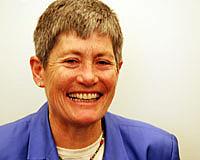"New media" at St. Louis Beacon means more than virtual engagement

A lot of the cool new things that the St. Louis Beacon is doing have a distinctly old ring to them.
They have a serious newsroom, to be sure - 15 journalists produce ten to 12 news and feature stories a day - and they are committed to new media and online publishing. But they are also taking their journalism offline. Once a month, the local news site hosts "Beacon and Eggs," which bring local experts into conversation with the communities that the Beacon covers. They also host "Barroom Conversations" every other week (with occasional breaks), where the Beacon buys the first round of drinks and host moderated discussions in local bars.
"People like to meet us, but they really like to talk to each other," said co-founder and editor Margaret Wolf Freivogel (left). On Friday, Freivogel spoke with this year's Online Community Building and Health Fellows about how her conception of journalism has changed.
Freivogel and several of her colleagues took buyouts from the St. Louis Post-Dispatch in 2005 and started the Beacon three years ago. "After we got out of there we realized there's this earthquake happening [in journalism]," she said. The quality of journalism and engagement are "of paramount importance" but a new news organization couldn't just move the words to the computer screen. Freivogel and her colleagues had to evolve in their thinking about what the role of a journalist might be. They decided not just to engage with social media, but to work with local partners to host in-person events.
This kind of broad engagement, Freivogel said, doesn't contradict her role as a journalist. "We're doing the same kind of work, we just have a lot more ways to connect that work to people who might find it useful. We also have a lot more ways to find sources than before."
Poynter has written about the Beacon's unique strategy, including a discussion of a year-long reporting and event project on race:
Freivogel said that early on, the Beacon recognized the value of partnerships. One of its biggest partnerships has been with the Missouri History Museum. Last year they co-sponsored a series of race-related talks and events, which helped draw attention to the Beacon's year-long 'Race, Frankly' series.
The Beacon also helped provide material for the museum's national exhibit, called 'Race: Why Are We So Different?' The exhibit didn't have any local content, so the Beacon wrote scripts for audio recordings of some of the site's race-related stories. The recordings ultimately served as the audio tour for the exhibit, which attracted about 22,000 visitors.
The Beacon is partnering with the museum again this year and has launched a new series to complement the museum's new series of speakers on class. The year-long series, called 'Class: The Great Divide,' looks at how class divisions shape the lives of St. Louis residents.
Similar to 'Race, Frankly,' the project has given the Beacon a chance to put a different spin on timely topics. On Opening Day, for instance, the series featured a story about how class divisions have played into the history of St. Louis baseball.
The point, Freivogel said after her presentation, is that technology is only as good as how it's used. Her vision of a new media organization is one that responds to the nature of the content of its reporting. It creates packages and multimedia, reaches out on Twitter and Facebook, hosts events and presents the news in whatever way it can to engage communities effectively. Because the "Race, Frankly" focused on a specific geographic part of St. Louis, for example, the website ran a special print version of the series to distribute in a small area.
The focus is on impact. You can tell people "post ten times a day on Facebook," Freivogel said. "But where does that get you? Sometimes there's a fascination with gimmicky technology."
In its five-year plan, the Beacon is looking for numbers and anecdotes beyond unique visitors that can help them track that impact, and also find out what they can do to turn engaged readers into involved participants, and eventually donors.
You can follow the weekend's conversations with the Online Community Building and Health Fellowships on Twitter at #ohjf.

